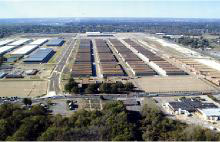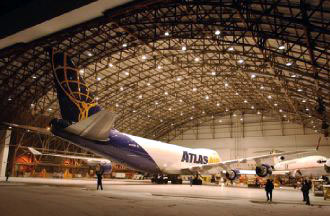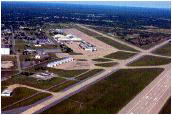everal commodities quickly
come to mind when thinking of Memphis. Barbecue
 |
| Location and a good supply of large buildings have made the Memphis Depot Business Park ideally suited for distribution operations. |
and the blues, to be sure. But the city is also known for its distribution
prowess and it still reigns as a nexus for cotton trade. Memphis-based
merchants typically sell about 30 percent of the U.S. annual cotton
production, according to the National Cotton Council. A former military
installation in the city has been quietly taking advantage of these
two major strengths of the region for the past few years.
The Memphis Depot Business Park has taken shape
in the years following the 1997 closure of the U.S. Army’s Memphis General
Depot, a facility activated in January 1942. The Depot’s first mission
was to supply the U.S. Army with food, clothing and equipment. It continued
to supply logistical support to troops through Desert Storm in the early
1990s. Now, refitted as a business park, the 642-acre (260-hectare)
complex houses operations by two of the three largest U.S. cotton merchants
and assorted light manufacturers.
“It’s a really unique situation and it’s great
space,” says William Zarfoss, administrative vice president for Allenberg
Cotton, a division of Louis Dreyfus Co. Allenberg merchandises U.S.
cotton worldwide, buying the natural fiber from producers and ginners.
Allenberg then stores, grades and ships it to U.S. textile mills based
on their needs. Allenberg owns or leases 5 million sq. ft. (464,500
sq. m.) of warehouse space across the U.S., and occupies 420,000 sq.
ft. (39,000 sq. m.) at the Depot.
“They’re old, but extremely well built,” Zarfoss
says of the former Army buildings. “Our requirements aren’t fancy. We
needed great, big empty boxes and that’s what they have, usually about
50,000 square feet [4,645 sq. m.].”
Zarfoss says Allenberg chose the site because it
was looking to expand its storage capacity and the facility has good
rail service. Allenberg’s operation serves as a consolidation point
as cotton is trucked in from all over the Mississippi River Delta.
Also distributing cotton from the Depot is Cargill
Cotton, a division of Cargill, Inc. Cargill is the Depot’s largest tenant,
leasing seven buildings with a total of 769,000 sq. ft. (71,400 sq.
m.).
“We found out our buildings are set up nicely for
cotton,” says Jim Covington, president of the Depot Redevelopment Corp.
(DRC). “The sizes are right and each bay has about 20,000 square feet
[1,860 sq. m.]. Fire codes and other regulations limit the amount of
cotton that can be stored in one building. Our buildings gave us an
opportunity to recruit cotton companies.”
Covington says that during the fall, there is a
non-stop progression of trucks hauling in raw cotton and its odor permeates
the business park.
NAID, an Association of Defense Communities (previously
known as the National Association of Installation Developers) honored
the Memphis Depot Business Park last summer with its 2004 Facility of
the Year Award. In presenting the award, Irene Kornelly, chairman of
the NAID/ADC Awards Committee stated, “The DRC’s success in transforming
this former Army installation into a vibrant commerce center is a leading
model for the reuse of a large inner city site.”
The DRC invested more than $18 million in the Depot’s
redevelopment, including $6.2 million from the U.S. Economic Development
Administration and $10 million in borrowed funds from city and county
governments. The business park has leased about 60 percent of its 4
million sq. ft. (371,600 sq. m.) of space and the 29 companies located
there employ about 1,200. About 60
 |

|
| Empire Aero provides maintenance and repair services to aircraft in its facility at Griffiss Technology Park in Rome, N.Y. |
percent is warehouse and distribution and the remainder is mostly light
manufacturing operations.
The business park is definitely in a prime location
for distribution. The Memphis International Airport, the FedEx world
hub and a UPS regional hub are all within two miles. Also nearby are
Interstates 240 and 55.
Over the last seven years, the DRC has modernized
utilities, roadways, parking, lighting and landscaping to bring the
park up to modern standards, Covington says. This included removal of
26 miles (42 km.) of surplus railway within the complex.
“We had to improve internal roadways, which were
built to 1942 standards,” Covington says. “We had to convert to a trucking
facility to provide room to park and maneuver 53-foot [16-m.] trucks.”
While redevelopment to date has involved existing
structures, Covington says the DRC is in the process of subdividing
100 acres (40 hectares) for new construction.
NAID/ADC gave its Developer of the Year Award to
Griffiss Local Development Corporation (GLDC) in Rome, N.Y., for its
efforts in transforming the former Griffiss Air Force Base into the
Griffiss Business & Technology Park, a focal point of economic activity
in the Rome area.
Since the base was closed in 1995, more than $165
million has been invested in infrastructure improvements. The facility
is now a blend of aviation and information technology-related firms,
according to Steven J. DiMeo, president of Mohawk Valley EDGE, which
provides staff to the GLDC.
The largest recent addition to the park is Empire
Aero Center, where Israel Aircraft Industries recently opened its North
American aviation maintenance headquarters, relocated from Miami International
Airport. Empire occupies nearly 400,000 sq. ft. (37,160 sq. m.) in an
expanded and refurbished hangar facility that previously serviced B-52
bombers. Empire provides heavy maintenance, structural repairs and refurbishment
to a variety of aircraft. The operation employs about 200 with plans
to ramp up to 500 by 2007.
Another addition to the park is the Air Force Research
Laboratory, which cut the ribbon in April 2004 on the new $25-million
headquarters for its Information Directorate.
BRAC 2005
Brings New Opportunities
There will soon be even more military property
available for redevelopment. Base Realignment & Closure (BRAC) in
the 1980s and 1990s closed 97 U.S. installations. Many other military
facilities have been shuttered through the years outside the BRAC
process.
The U.S. Dept. of Defense is currently gathering
information on the nation’s military installations in preparation
for the largest BRAC round yet, which will dispose of 21 percent to
25 percent of the military’s infrastructure.
The DOD says decisions to keep bases open will
be based on military value and other factors, including the ability
to support joint operations of several branches of the armed services.
Harry Kelso, a Virginia-based consultant specializing
in redevelopment of military property, says most states have made
little effort towards thinking of ways to reuse the properties that
may be closed. Instead, most have tried to make the case for keeping
bases open.
“State and local governments are spending an
extraordinary amount of time and funds in an attempt to BRAC-proof
facilities and candidly, that’s impossible to do,” Kelso says. He
cites Virginia Gov. Mark Warner as one of the few public officials
who have talked about a “Plan B” for when and if bases close.
“States need to be taking the proactive posture
of addressing what would happen to the economy and local communities
in the event bases close,” Kelso says. “Corporations and site selection
officials should be gaining the expertise today to prepare themselves
for the opportunities presented by base closures.” Kelso adds that
these opportunities are already available at the dozens of U.S. bases
currently being redeveloped.
